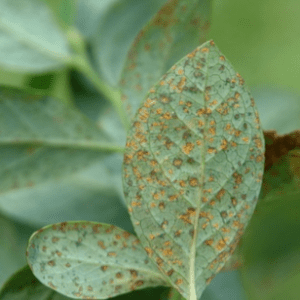Blueberry rust has been identified in rabbiteye blueberries in Alabama, according to Alabama Extension. It has the potential to be very damaging to yields and is most prevalent in the Southeast. Rabbiteye cultivars suffer from premature defoliation, while highbush blueberries are subject to occasional localized outbreaks.

It is important to scout blueberries to see if symptoms are present. Yellow leaf spots can emerge on the upper leaf surface of newly emerged leaves. If the disease progresses, those spots will turn reddish brown in color. All the leaves may turn brown, die and drop prematurely if the infections are severe enough. Yellowish orange pustules become visible on the lower leaf surface around mid-summer.
Blueberry rust can result in yield loss and reduced flower buds the following season because of defoliation in vulnerable varieties.
Management of the disease includes removing hemlock trees within a third of a mile; avoid susceptible cultivars; limit overhead irrigation and apply effective fungicides.
Fungicide sprays may also cause phytotoxicity to blueberry leaves, so they must first be tested, and tank mixes of incompatible products must be avoided. For current fungicide recommendations, consult your local extension agent or see the Southeast Regional Blueberry Integrated Management Guide.
One of the best management tactics is to plant a resistant variety. Northern highbush varieties resistant to blueberry rust include: Bluecrop, Burlington, Collins, Dixie, Earliblue, Gem, Ivanhoe, Olympia, Stanley and Weymouth.









